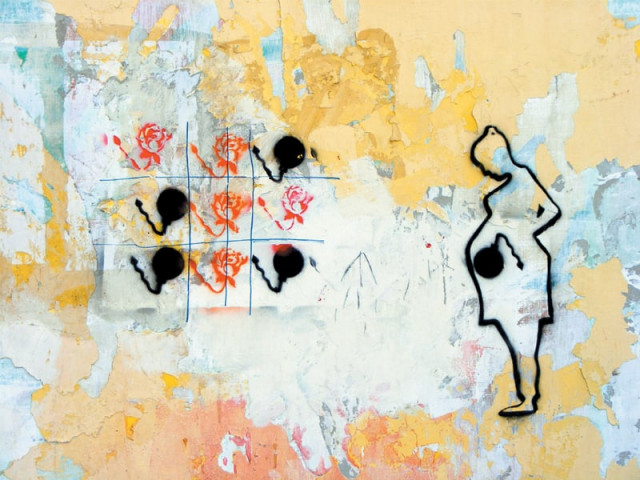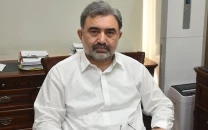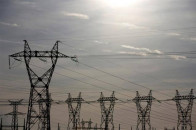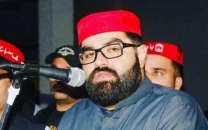Spray it dont say it
Closer to home, it seems that art, and street art in particular, truly does reflect life.

The car slows down and two people get out, one holding the tools of his trade in his hands as the others scans the road. Assured that the coast is clear, they get to work. A few minutes later, their job is complete, and they get back in the car and disappear into the night.
On the plain white wall they were parked next to is now what appears to be the figure of a woman with her skirt flaring up, as in the iconic Marilyn Monroe shot. Look closer and you’ll see that it’s not a skirt at all, but a burqa.
Twenty-one-year-old Sajid* and his friends are not, as you may have guessed, mobile snatchers or target killers. They are instead part of a small but growing breed of street artists who have turned the walls of Karachi into their canvases.
“The sexuality of Marilyn Monroe will go down through the ages, and I think I was trying to merge that image with the idea that there is a person behind the burqa, that just because you’re in a burqa, whether you choose to be or are compelled to be in one, doesn’t mean you are not a person, and a sexual person at that,” says Sajid*, who has been painting these ‘burqilyns’ for the last three years. “It was a way to get people to notice something or even get a little bit offended. I just wanted to create a thought process in a person that, whether or not they make the Marilyn connection, they will understand what the image means. And even if people are completely outraged, I just want to bring about an emotional response in people who see it.”
Artists the world over have been using the streets as their canvas for ages and street art, or graffiti in particular, has many political undertones. Though often considered a form of vandalism, protest art in the form of graffiti is a global concept which, some claim, has been around since the time of ancient Greece and the Roman Empire.
In 1970s America, graffiti was often associated with the then-grimy subways of New York City. However, in the last few decades graffiti has come into its own, and is recognised as a legitimate form of street art, and a uniquely urban one at that. It is a form of art that is purely for public consumption, and that eschews the limiting canvasses and studios in favour of the expanses of walls and alleys.
The political element is ever-present in street art, and the divisive Berlin wall was memorably covered with colourful graffiti (at least on the Western side) as an expression of protest against the East German regime. In the present day, Israel’s ‘security wall’ is also covered in protest graffiti.
Closer to home, it seems that art, and street art in particular, truly does reflect life. “One can argue that most contemporary Pakistani art is a kind of protest art and is certainly deeply politicised, especially as far as the work of younger artists is concerned,” says Durriya Kazi, chairperson of the department of visual studies at the University of Karachi.
Sajid agrees, saying that he turns to real news events for inspiration for his work. “I was obsessed with the burqa for some reason and I think it may have something to do with the Lal Masjid episode. I was just fascinated by how Mullah Abdul Aziz tried to escape wearing a burqa and got caught,” he says.
It’s not only politics and social commentary that is reflected in Sajid’s street work. The ever-present threat of violence that Karachiites live with is also reflected in his work, as is evident in his spray-painted image of a corpse’s outline.
“As I was growing up, watching the news, watching the state of the country, I had this sense of frustration, of being unable to control what was happening and being unable to change it,” he pauses, as if in reflection. “I think the graffiti thing started basically as my way of trying to voice my opinions,” he says.
He’s not the only one to draw inspiration from chaos and violence, during Karachi’s last spate of target killings, a group of artists painted stencils for peace in the city — displayed on Facebook as ‘Rang de Karachi’.
Graffiti is only the latest addition to a long-standing tradition of artistic protest in Pakistan, protests that have taken the form of poetry and literature as well as art. The long periods of military rule, in particular, were fertile ground for such endeavours, and it is only fitting that Faiz Ahmed Faiz’s poetry is the inspiration behind Sajid’s body piece. The outline of the body is formed by words from Faiz’s poem Intisaab, and within this outline is the line “Un dukhi maaon ke naam” (In the name of those sad mothers).
“The first line reads ‘zard patone ka bun jo mera des hai’ (A forest of dying leaves that is my country) which is something I felt like I could relate to so strongly, just because of what the country had become,” says Sajid. “And this was a poem that was written decades ago, but still from then till 2012, nothing has really changed.”
But what’s art to some, is vandalism to others. Much of the artwork he has scrawled on the walls of Zamzama has been whitewashed, and given the often controversial nature of his work, one would imagine the fear of getting caught looms large on his mind. But Sajid claims that really isn’t an issue as he uses the cover of the night to shield his identity, and chooses to remain anonymous as an artist. “Anything in Pakistan can be considered blasphemous,” declares Sajid. “You can misconstrue anything to make it sound or look blasphemous, if you really want to. A lot of the ‘Marilyns’ have been blacked out by people, and many times I have painted something in the night, only to find that someone has covered it with paint or a poster in the morning.”
The short shelf life of his work is something he seems to have learned to live with. “That’s just part of the work,” he says. “You’re creating emotions, some people will love it and some people won’t, but either way it’s at least getting people to start thinking.”
Sajid is certainly not the first Pakistani artist to turn bare walls into his canvas. Sadeqain started this tradition by painting large murals at Jinnah Hospital (now destroyed) and Frere Hall as well. The late Asim Butt is known for his subversive street art work as well. His mural painted across the street from Shah Ghazi’s mazaar in Karachi showcases his exemplary skills as an artist who really understood art made for public consumption.
Similar to Sajid’s work, Butt’s street art was also politically inspired. He launched an art protest movement after military dictator General Pervez Musharraf declared a state of emergency in 2007, providing posters to protesters. His ‘eject’ symbol, spray painted on street walls, quickly became a popular symbol for the pro-democracy movement which led to the eventual ouster of General Musharraf in 2009.
But Professor Durriya Kazi says Butt’s contribution to the art world is far greater than his street work alone. “His murals were not objects for sale,” she says. “It was a generous sharing of his vision with wider and often unknown audiences instead of the controlled audience of the gallery.”
It is this very concept of drawing an audience from beyond the limited circles of gallery goers that has attracted Sajid to street art as well. He says that even though he doesn’t spray paint till dark, a few stragglers do stop and watch what he is doing. He recalls one evening while painting the time bomb piece “this one man came up to me and told me that he thought what I was doing is a great idea, and that we should come do this on the walls of Korangi where he lives, because he thought people in that part of town would really appreciate it.”
Having his work hang on a canvas in a gallery would rob him of such interactions, he says. Since drawing out emotions from his audience is his target, he says seeing such reactions on the street, or reading people blog about his work without knowing who he is, is satisfaction enough.
Meanwhile, as far as street art in Pakistan as a whole is concerned, other artists are bound to step up and add their unique visions to the walls of our towns and cities. Since much of the work is politically inspired, it doesn’t seem as if that particular source of material will dry up anytime soon. “The movement for artists to come out on the streets and join in the growing protests is slow in coming, but seems to be gaining momentum,” says a hopeful Kazi. “It remains to be seen how many can drag themselves away from the seduction or habit of the gallery, which is an important venue for their economic survival.”
Published in The Express Tribune, Sunday Magazine, February 5th, 2012.



















COMMENTS
Comments are moderated and generally will be posted if they are on-topic and not abusive.
For more information, please see our Comments FAQ